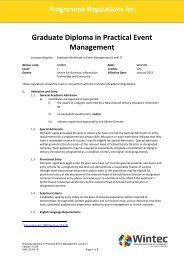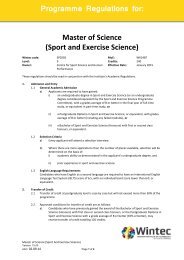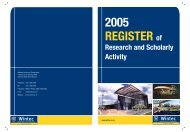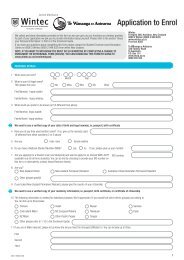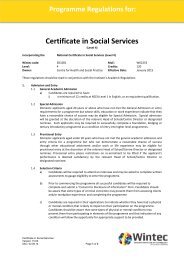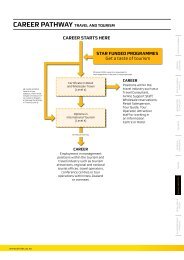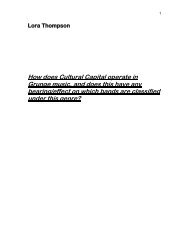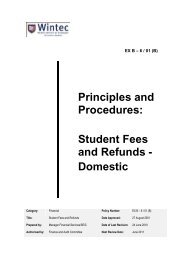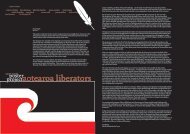Wintec Annual Report 2009
Wintec Annual Report 2009
Wintec Annual Report 2009
You also want an ePaper? Increase the reach of your titles
YUMPU automatically turns print PDFs into web optimized ePapers that Google loves.
FINANCIAL PERFORMANCE<br />
NOTES TO THE FINANCIAL STATEMENTS (CONT)<br />
FOR THE YEAR ENDED 31 DECEMBER <strong>2009</strong><br />
If impairment evidence exists for investments at<br />
fair value through other comprehensive income,<br />
the cumulative loss (measured as the difference<br />
between the acquisition cost and the current fair<br />
value, less any impairment loss on that financial<br />
asset previously recognised in the surplus or deficit)<br />
recognised in other comprehensive income is<br />
reclassified from equity to the surplus or deficit.<br />
Equity instrument impairment losses recognised in<br />
the surplus or deficit are not reversed through the<br />
surplus or deficit.<br />
If in a subsequent period the fair value of a debt<br />
instrument increases and the increase can be<br />
objectively related to an event occurring after the<br />
impairment loss was recognised, the impairment<br />
loss is reversed in the surplus or deficit.<br />
r) Income Tax<br />
The institute is exempt from income tax and,<br />
therefore, the financial statements do not contain<br />
any provision for income tax.<br />
s) De-recognition of Financial Instruments<br />
The de-recognition of a financial instrument takes<br />
place when the Institute no longer controls the<br />
contractual rights that comprise the financial<br />
instrument, which is normally the case when the<br />
instrument is sold, or all the cash flows attributable<br />
to the instrument are passed through to an<br />
independent third party.<br />
t) Changes in Accounting Estimates<br />
There have been no changes in accounting<br />
estimates during the period.<br />
u) Financial Risk Management Objectives<br />
and Policies<br />
The Institute’s principal financial instruments<br />
comprise receivables, payables, bank loans and<br />
overdrafts, available for sale investments, cash<br />
and short-term deposits. The institute manages<br />
its exposure to key financial risks, including<br />
interest rate and currency risk in accordance<br />
with the Institute’s financial risk management<br />
policy. The objective of the policy is to support<br />
the delivery of the Institute’s financial targets<br />
whilst protecting future financial security.<br />
The main risks arising from the Institute’s financial<br />
instruments are interest rate risk, foreign currency<br />
risk, credit risk and liquidity risk. The Institute<br />
uses different methods to measure and manage<br />
different types of risks to which it is exposed.<br />
These include monitoring levels of exposure<br />
to interest rate and foreign exchange risk and<br />
assessments of market forecasts for interest<br />
rate, foreign exchange and commodity prices.<br />
Ageing analyses and monitoring of specific<br />
credit allowances are undertaken to manage<br />
credit risk, liquidity risk is monitored through the<br />
development of future rolling cash flow forecasts.<br />
Council reviews and agrees policies for managing<br />
each of these risks as summarised below.<br />
Primary responsibility for identification and control<br />
of financial risks rests with the Finance and<br />
Audit Committee under the authority of Council.<br />
Council reviews and agrees policies for managing<br />
each of the risks identified below, including the<br />
setting of limits for trading in derivatives, hedging<br />
cover of foreign currency and interest rate risk,<br />
credit allowances, and future cash flow forecast<br />
projections.<br />
w) Risk Exposures and Responses<br />
Interest rate risk<br />
The Institute’s exposure to market interest rates<br />
relates primarily to the Institute’s long-term debt<br />
obligations. The level of debt is disclosed in the<br />
notes to the financial statements.<br />
The Institute constantly analyses its interest rate<br />
exposure. Within this analysis consideration is given<br />
to potential renewals of existing positions, alternative<br />
financing, alternative hedging positions and the mix<br />
of fixed and variable interest rates.<br />
Foreign currency risk<br />
The Institute only has limited exposure to foreign<br />
currency risk. All fees are denominated in NZ<br />
Dollars to diminish risks associated with revenue<br />
streams. Where transactions in foreign currencies<br />
are forecast that are material to the Institute forward<br />
exchange contracts are entered into to diminish the<br />
risk of the group to fluctuations in exchange rates.<br />
Credit risk<br />
Credit risk arises from the financial assets of the<br />
Institute, which comprise cash and cash equivalents,<br />
trade and other receivables, available-for-sale<br />
financial assets and derivative instruments.<br />
The Institute’s exposure to credit risk arises from<br />
potential default of the counter party, with a<br />
maximum exposure equal to the carrying amount<br />
of these instruments. Exposure at balance date is<br />
addressed in each applicable note. The Institute<br />
does not hold any credit derivatives to offset its<br />
credit exposure. The Institute trades only with<br />
recognised, creditworthy third parties, and as such<br />
collateral is not requested nor is it the institute’s<br />
policy to securitise its trade and other receivables.<br />
In addition, receivable balances are monitored on an<br />
ongoing basis with the result that the institute’s<br />
exposure to bad debts is not significant. There are<br />
no significant concentrations of credit risk within the<br />
institute and financial instruments are spread amongst<br />
a number of financial institutions to minimise the<br />
risk of default of counterparties.<br />
<strong>Wintec</strong> <strong>Annual</strong> <strong>Report</strong> <strong>2009</strong> _ 47



